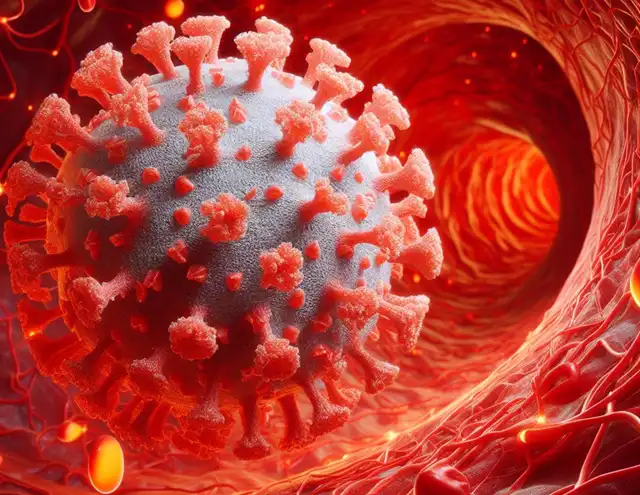SARS-CoV-2 Variant BA.2.86: Increased Lung Cell Affinity and Severity Concerns
- Normal Liver Cells Found to Promote Cancer Metastasis to the Liver
- Nearly 80% Complete Remission: Breakthrough in ADC Anti-Tumor Treatment
- Vaccination Against Common Diseases May Prevent Dementia!
- New Alzheimer’s Disease (AD) Diagnosis and Staging Criteria
- Breakthrough in Alzheimer’s Disease: New Nasal Spray Halts Cognitive Decline by Targeting Toxic Protein
- Can the Tap Water at the Paris Olympics be Drunk Directly?
SARS-CoV-2 Variant BA.2.86: Increased Lung Cell Affinity and Severity Concerns
- Should China be held legally responsible for the US’s $18 trillion COVID losses?
- CT Radiation Exposure Linked to Blood Cancer in Children and Adolescents
- FDA has mandated a top-level black box warning for all marketed CAR-T therapies
- Can people with high blood pressure eat peanuts?
- What is the difference between dopamine and dobutamine?
- How long can the patient live after heart stent surgery?
SARS-CoV-2 Variant BA.2.86: Increased Lung Cell Affinity and Severity Concerns
The newly identified SARS-CoV-2 variant, BA.2.86, has been found to have an increased affinity for infecting lung cells, potentially leading to more severe diseases, according to a recent study by researchers at Ohio State University.
The BA.2.86 variant, discovered in August 2023, stands out among the Omicron variants for its heightened ability to infect specific lung cells. The study suggests that BA.2.86 may result in a severity of COVID-19 similar to the destructive Delta variant from 2021.
Despite BA.2.86 displaying characteristics that could lead to more severe diseases, researchers are cautiously observing its behavior. While it seems to have features that may contribute to increased disease severity, these come at the cost of reduced transmissibility. The immune evasion capability of BA.2.86 is significantly weaker compared to the XBB variant, allowing individuals with previous immunity to likely effectively resist it.
However, the concern arises as BA.2.86, after a single mutation, transformed into a virus known as JN.1, which exhibited an incredible level of immune evasion. Within a few months, JN.1 became the predominant SARS-CoV-2 variant, causing widespread infections during the New Year period in 2024.
Recent cell culture studies have magnified the understanding of BA.2.86, shedding light on how this novel coronavirus variant evades antibodies and enters human cells. The research confirms earlier epidemiological findings that BA.2.86 has weaker immune evasion capabilities compared to the XBB variant. Therefore, it is less likely to become a dominant variant at least until it transitions into JN.1.
However, a more alarming discovery is that BA.2.86 exhibits enhanced capabilities to infect lung cells named CaLu-3. These cells, located in the lower lungs, are lined with a surface protein called TMPRSS2.
SARS-CoV-2 typically enters human cells through two different surface proteins: ACE2 and TMPRSS2. When the virus mutates into the Omicron variant, it tends to prioritize ACE2 for cell entry, leading to higher transmissibility and lower severity, explaining the milder characteristics of Omicron diseases.
Senior author of the latest study, Shan-Lu Liu, points out that BA.2.86 can better enter CaLu-3 lung cells than any COVID variant since Delta. This suggests that, compared to previous Omicron or XBB variants, this viral sublineage may lead to more severe diseases.
Liu states, “…BA.2.86 seems to enhance infectivity to human lung epithelial cells, so that’s a bit worrisome. Consistent with infectivity, its fusion activity with human lung epithelial cells is also enhanced. This raises concerns about whether this virus may have a potentially greater pathogenicity than the recent Omicron variants.”
As of the latest report from the Centers for Disease Control and Prevention (CDC), there is no evidence suggesting that JN.1 causes more severe diseases compared to other prevalent variants. However, Liu remains cautious, noting that BA.2.86’s ability to infect certain lung cells is a notable feature of early severe SARS-CoV-2 variants. With global infection rates at such high levels, the virus is likely to continue evolving towards variants that could lead to more severe diseases.
Liu explains, “The concern is whether this variant and its descendants, including JN.1, will increase the tendency to infect human lung epithelial cells, similar to the parent virus that caused the major outbreak in 2020. We know coronaviruses easily undergo viral recombination, which could result in new variants with increased immune evasion capabilities and severity of the disease. That’s why ongoing monitoring of variants remains crucial, even as we approach the end of the fourth year of the pandemic.”

SARS-CoV-2 Variant BA.2.86: Increased Lung Cell Affinity and Severity Concerns
(source:internet, reference only)
Disclaimer of medicaltrend.org
Important Note: The information provided is for informational purposes only and should not be considered as medical advice.



